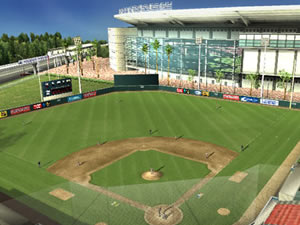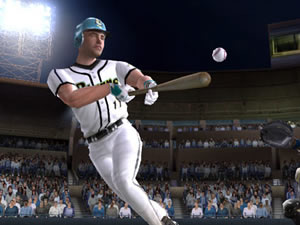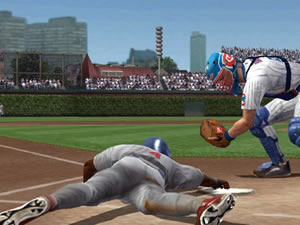Money ball.
Contrary to what video games depict, there’s more to baseball than swinging bats and throwing balls. There are ‘roids and mascots and vendors and parents trying to find their kids, who are likely hanging out at the bullpen harassing the relievers. Every single game is a buzzing, confusing mess involving thousands of people engaged in countless activities; if publishers insist on releasing annual installments of their baseball games, then they should include some playable content that reflects these realities.
Instead, EA built plenty of abstract managerial content into their latest upgrade, MVP Baseball 2005. By and large, this version is just as good as last year’s, which is to say that it’s another strong, solid baseball game through and through. But micromanagement is not a game – it’s most people’s crappy job. Sure, budget reports and fiscal concerns add depth, but if I wanted to be crunching numbers right now, I’d be doing my taxes.
Then again, if you happen to like random acts of subtraction and idolized The Count as a child, you’ll probably love Owner’s mode, MVP 2005‘s major new feature.
Most of the fun to be had in Owner’s mode can be found in the Owner’s box. Here, according to the instruction manual, you will “Make and review key decisions about team finances, pricing, ballpark assets, coaching staff, and much more. This is the financial hub of the organization. You’ll spend a lot of time here attempting to balance your budget.” Promise? To be fair, you’ll also have to manage team chemistry (not the Balco kind) as well as fan happiness while trying to meet certain short and long-range goals.
You can even customize your very own ballpark, although the options here are much more limited than you might imagine. You only get a handful of field shapes to choose from, plus a couple color choices for the outfield wall and a mere two mow patterns. The real customization begins later, when you gain the funds to add luxury boxes and upper-decks. But if you want to screw around and make completely impractical, obstacle laden fields, you’ll probably be disappointed, because MVP 2005‘s field options are limited to the basics.
If balancing a budget isn’t your idea of fun, you can always settle for Dynasty mode, in which you’ll have to balance team chemistry and strive to reach goals without the burden of pricing hot dogs. Since Division A teams and rosters have been included this year, you can mess around with a three-tiered farm-system. This addition makes sense and finally fleshes out the minor leagues for the more zealous armchair managers.
We wish, though, that more had been done to give the minor league teams and games a raunchy, fun atmosphere. Including the Famous Chicken would have helped tremendously on this front. As they are, minor league games are just crappy versions of pro-games. No one has any skills and you’ll see a lot of botched plays. Now that I think about it, maybe that is the spirit of minor league games.
Exhibition mode, a Scenario Editor, a hands-off Manager mode and a Homerun Derby are back and the same as last year. There are also a couple nifty mini-games, which are a decent novelty. They’re also integrated into the Owner and Dynasty modes as you can play them during the off-season to boost some of your players’ stats.
 One of the mini-games is a batting challenge in which you pick a batter and then hit the ball where prompted. Ramps on the field will help your hits travel farther, and random tractors cruising through the outfield will grant bonus points if struck. This is a useful little training game, because batting in MVP 2005 is extremely sensitive. You’ll want to practice before jumping into a season, and this is the perfect opportunity.
One of the mini-games is a batting challenge in which you pick a batter and then hit the ball where prompted. Ramps on the field will help your hits travel farther, and random tractors cruising through the outfield will grant bonus points if struck. This is a useful little training game, because batting in MVP 2005 is extremely sensitive. You’ll want to practice before jumping into a season, and this is the perfect opportunity.
The other mini-game, a pitching-puzzle game in which the strike zone is filled with blocks of different colors, is far less practical. It’s an interesting take on a generic puzzle game that you’ll probably play once and then promptly ignore.
What set MVP 2004 apart from the competition was its awesome gameplay. Luckily, MVP 2005 features the exact same thing with just a few tweaks. Pitching, for example, is the same as it was last year, except the chargeable meter moves faster after a hit is given up. The system is still very rational and intuitive, and is certainly one of the smartest in the genre.
Fielding is still mapped to the R-stick, but players won’t actually reach for the ball or try to catch it. Their moves are static; you have to hope they dive in just the right way to make a catch. Since players under your control exhibit zero A.I., you’ll sometimes dive for a ball and think you’ve caught it only to see it sitting there at your player’s feet when he stands up. It can also be really tough to figure out which player the game has decided you should control in time to make a play. The system isn’t any better than it was last year, and that makes it worse.
Batting is also the same as it was last year, with the exception of Hitter’s Eye. Thanks to Hitter’s Eye, every time a ball is released from the pitcher’s hand it will flash a color that corresponds to a pitch type. For example, if the ball flashes red, the batter knows a curveball or slider is coming and can swing accordingly. It’s a simple, useful feature that helps set MVP apart from other games this year.
 Another nice new feature is Call Arguing. If you think an ump makes a bad call, you can now have managers argue calls. After a questionable call is made, you can press a button to have your manager start griping. If you keep pressing the button he’ll get himself thrown out of the game, which in some circumstances will provide a stats boost to your players.
Another nice new feature is Call Arguing. If you think an ump makes a bad call, you can now have managers argue calls. After a questionable call is made, you can press a button to have your manager start griping. If you keep pressing the button he’ll get himself thrown out of the game, which in some circumstances will provide a stats boost to your players.
Too bad you can’t boost the graphics, thgouh, because MVP 2005 doesn’t look so hot. It contains an awesome assortment of motion-captured animations, which are crucial, but the overall appearance is drab and murky on every system. Loading times vary, however, and in this regard the Xbox version is superior as it spends relatively little time loading. Compared to the smooth look of MLB 2K5, MVP is at least a step behind.
The sound effects are fine, and the music is comprised of a short list of aggravating pop songs. Sadly, the commentary is the worst I’ve listened to in years. I must have heard the line “Ya can’t hit the ball if ya don’t swing the bat, meat,” a dozen times in a single, nine-inning game. Fortunately, you can take that noise out of the ballgame.
You can also customize MVP 2005 in a myriad of other ways by tuning the gameplay settings. Theoretically, you should be able to tailor the experience to your exact preferences, but batting and pitching still feels pretty much the same no matter how you change various values. We appreciate the ability to subtly tweak the gameplay, but we also would have appreciated the ability to completely break it.
As always, playing with friends is more fun than alone, and online play is fine on both the PS2 and Xbox versions. Lag can certainly ruin a game, but it’s easy enough to find another one. Basic tournaments can be set up, which is nice, but pales compared to MLB 2K5‘s online league system.
EA is known for great gameplay innovation, and every couple of years they show consumers why. 2005, though, is not one of those years. Instead of focusing on cool new mechanics, MVP Baseball 2005 focuses on adding lots of relatively useless stuff. Sure, you can build a stadium, but you can’t play with it. You can arrange fan-appreciation days, but you can’t set bees loose on the fans once they’ve gathered. If MVP Baseball 2004 was Alec Baldwin, MVP Baseball 2005 is Daniel – mostly the same, but a little bit sleazier.











